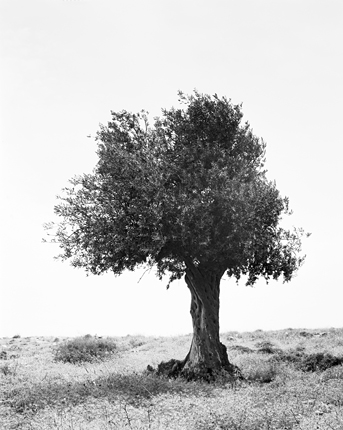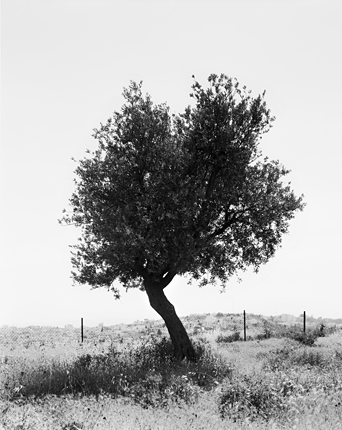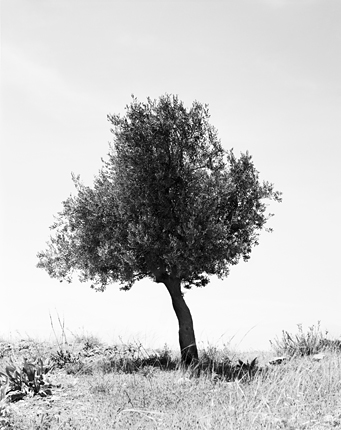The olive trees seen here are from Facts on the Ground, a series of photographs made in the misleading landscape of Israel/Palestine. The photographs describe the enduring ways the violent history and present policies of the Israeli Occupation have transformed the land.
Facts on the Ground consists of three types of intersecting landscapes that have been shaped by Israel’s displacement of the Palestinian people in its ongoing attempt to create a Jewish state. The first are the ruins of Palestinian villages, which were systematically destroyed by the Israeli military in 1948 during the founding of the state (referred to by Palestinians as the Nakba, or Catastrophe). The 750,000 Palestinians forcibly removed from their homes, along with their descendants, are to this day living as refugees and exiles throughout the world. The sites of these villages have been renamed, built over, or made into parks, but the remains are a persistent reminder of an exiled people. The second part of Facts on the Ground are these untended olive trees that mark the landscape of the West Bank. While the trees appear neglected, they are in reality a by-product of Israeli policy in the Occupied Territories. The Israeli settlements, the Separation Wall, military checkpoints, and the segregated roads that criss-cross the West Bank have made countless olive orchards inaccessible to the Palestinian farmers who have depended on them for generations. Cutting off farmers from their land is a cruel strategy of symbolic and economic discouragement.
The Settlements, the third part in this series, are the main instrument used to impose, expand and cement Israeli control in the Occupied Territories. They are now home to a half million Israelis and one of the main obstacles in any peace process. The term “facts on the ground” is used to describe these housing developments that are intended to establish permanent Israeli presence in Palestinian territory, in effect negating Palestinian claims to their land. The scale of some of these projects is so vast and the ongoing construction so blatant, it’s difficult to reconcile that their existence is illegal under international law.
For the majority of non-Palestinians, the dominant Israeli narrative invites one to look away from recent history and current policies of encroachment. We made the photographs in Facts on the Ground with a large format camera, which describes the world in precise detail and compels one to look at the landscape with great deliberation. The photographs stay away from the dramatic violence of the conflict that is frequently seen in the news, and reveal instead the enduring ways the Occupation has shaped and altered the landscape.
Being both American and Jewish, Facts on the Ground is a reckoning with our own nationalities and backgrounds. US foreign policy, ever favorable towards Israel, is one of the factors that legitimizes and enables the cruelties, small and great, that Israel inflicts on the Palestinian people. Being Jewish means that Israel, the Jewish State, performs these injustices in our name. The conflict in Israel/Palestine is often portrayed as timeless and deeply complex, a portrayal which actively discourages scrutiny of recent and current policies. And while the path to any future resolution will be complex, the history of the conflict and the methods of the Occupation are more blatant than many want to admit. They are stamped on the land.
Sasha Bezzubov and Jessica Sucher






